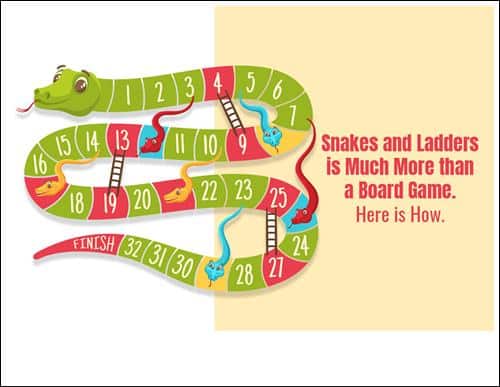
In its early years, Snakes and ladders was vastly different from the game we are familiar with today. The participants who played the game in the days gone by stumbled upon ladders labelled with virtues such as ‘faith,’ ‘kindness,’ or ‘forgiveness.’ These ladders were a boon as they got to climb up them and arrived nearer to their goal of salvation. On the other hand, if they landed on spots inscribed with descriptions of vices such as cruelty, greed, or pride, they were unlucky enough to get bitten by the snakes and wind up to where the tail ends. This was the predominantly played variant of snakes and ladders all through to the twentieth century and was later tweaked, the result of which was the shedding of all its moral edifices. The cultural significance of snakes and ladders, along with other equally ancient board games, has been embodied vividly by Sahapedia. What you have read thus far is merely the tip of the iceberg, with plenty more reasons why snakes and ladders are regarded as much more than a board game.
1. Deep Connections To Indian History:
Enthusiasts and others who play snakes and ladders should be aware of its rich historical tapestry, which has largely influenced the game’s modern iteration. In its earliest versions, snakes and ladders had a quasi-religious nature and was widely referred to by the name gyanbazi or game of knowledge. It was popular among the erstwhile royals of Rajasthan in the eighteenth and nineteenth centuries. The palace women, in particular, took to the game with great gusto. Snakes and ladders is universally loved in India and has been known to have boards aligning with Hindu, Muslim, and Jain schools of thought in the past. The game was thought to be popular among the Jain nuns of ancient India and an enlightening spiritual pursuit. Ancient Jain snakes and ladders boards adopted the format of eighty-four numbered squares indicative of a human’s progress through life. Each of the eighty-four squares was inscribed with words highlighting the conduct to be expected and the corresponding good and dire consequences arising thereof. The ladders are meant to convey the rewards of positive behavior, while the presence of snakes implies the pitfalls of deplorable deeds.
The very top of the board depicted a four-tiered pavilion symbolizing the heavens. At the summit of this structure is the crescent-shaped siddhasaila, or abode of the enlightened, which peacocks flank. To attain this prestigious state, a Jain is expected to avoid all forms of misconduct and remain steadfast in pursuing knowledge. The pavilion itself has towards its fringes a seven-headed horse on which the sun god is perched. On the other side is the rendering of the moon god astride an antelope.
2. Second To None In Fame:
Very few board games have borne witness to the kind of popularity that snakes and ladders has demonstrated. Only the equally ancient games of chess and ludo have rivalled snakes and ladders for a space in the spotlight, with each game having its own avid share of fans.
3. Has Stood The Test Of Time:
It has aged rather well for a game that has been around for ten centuries and counting. While the subsequent snakes and ladders variants have not reinvented the wheel, the tweaks brought about by the manufacturers have revitalized it and have made the modern consumer aware of the product. Along the way, it lost its moral bearing but, in exchange, gained a worldwide fan following and critical acclaim. From this point on, it only saw further phenomenal success as it eased its way online almost unnoticed. Such is the versatility of the ancient game of snakes and ladders. While it still held on to its fame, going online was undeniably a shot in the arm. Gaining popularity among digital natives has worked to ensure its longevity for eons more.
4. Teaches Lessons In Humility:
Humility is a necessary tool in life as it is an endearing attribute, and snakes and ladders explicitly imparts this knowledge to us. When good fortune comes our way, it is natural that we tend to put on a display of ecstasy. While doing so, we should also showcase a sense of empathy toward those who are languishing behind us. Likewise, in the real world, it is necessary for us to manifest affirmations of empathy for the less fortunate people we stumble across. Even though we have made it big, that rug may be pulled from under our feet at any time, as there are no guarantees in life.
5. Experiencing Steady Progress Is Acceptable:
To use a well-known metaphor, both snakes and ladders, and life have see-saw-like tendencies. There are roadblocks to contend with both in the game and in our existence. While snakes signify the roadblocks in the game, they are heralded in real life by impediments to the smooth running of businesses. When faced with such situations, it’s acceptable to slow down the pace of growth and change our perspective of the existing situation. When we see the current circumstances in a different light, we would once again set foot on the ladder in both snakes and ladders and in the real world. In all these ways and more, snakes and ladders have transcended beyond the ordinary. As time marched on, it subsequently lost all traces of seriousness and became a purely recreational activity. By staying informed on the game’s remarkable past, we are aware of the profound influence it had in the days of yore.
Leave a Reply
You must be logged in to post a comment.